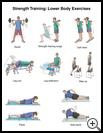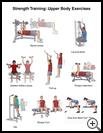
Weight Training for Children and Teens
________________________________________________________________________
KEY POINTS
- Strength training includes using weights, resistance bands, or doing exercises such as push-ups or lunges that use your child's own body weight.
- Check with your child's healthcare provider before your child starts a weight training program. This is very important if your child or teen has a health problem such as asthma, diabetes, or a heart problem.
- Your child should enjoy strength training, but he or she should also take it seriously. Safety must always come first. Make sure that your child will be supervised by a certified adult.
________________________________________________________________________
What is weight training?
Weight training, or strength training, means doing exercises that build muscle strength. There are many ways to build muscle:
- Use body weight such as with push-ups, pull-ups or sit-ups
- Use rubber tubing called resistance bands
- Lift free weights such as dumbbells
- Use weight machines
Strength training makes muscles stronger by asking them to do more than usual. Strength training must be done gradually and carefully.
Is it good for children and teens?
Weight training can:
- Create lifelong interest in health and fitness
- Teach healthy habits at a young age
- Help prevent overuse injuries in sports
- Increase strength and the ability stay active for a longer time without getting tired
- Decrease the risk of obesity during childhood and as an adult
- Increase bone strength
- Improve self-esteem
The American College of Sports Medicine, the American Medical Society of Sports Medicine, and the American Academy of Pediatrics have all said that weight training is safe for children as young as 8 years of age.
How do we get started?
Check with your child's healthcare provider before your child starts a weight training program. This is very important if your child or teen has a health problem such as asthma, diabetes, or a heart problem.
- Make sure that your child is old enough to follow instructions. Your child should enjoy strength training, but he or she should take it seriously. Safety must always come first. Make sure that your child will be supervised by a certified adult. The instructor must make sure that your child has correct form on all movements and exercises.
- The area where your child trains should have plenty of open space.
- Your child should warm up before each training session with 5 to 10 minutes of walking, jogging in place, or jumping rope. This helps prevent injury. Stretching after workouts helps to relax the muscles and reduce soreness.
For children who are weight training:
- Teach proper warm-up exercises.
- Your child should start with exercises that use his or her own body weight first. Your child can work with weights as strength increases. Body weight exercises include:
- Jumping rope
- Jumping jacks
- Push-ups
- Running drills
- Abdominal crunches
- Keep workouts short and change the routine often to keep children interested.
For teens who are strength training:
- Do body weight exercises such as:
- Pull-ups or chin-ups
- Dips
- Squats and lunges
- When lifting weights, focus on correct form. It’s usually best to do more repetitions (reps) instead of lifting heavier weights. The coach or trainer can guide teens to prevent injury.
Last modified: 2019-11-21
Last reviewed: 2019-08-22


